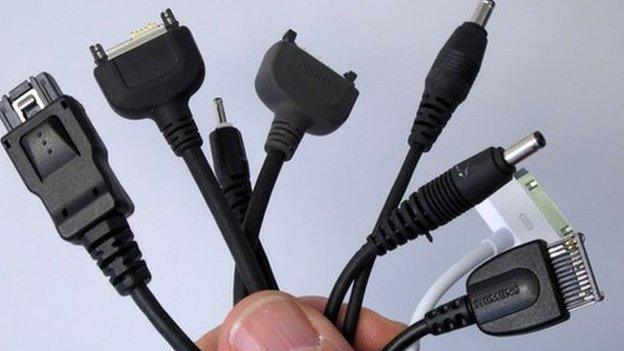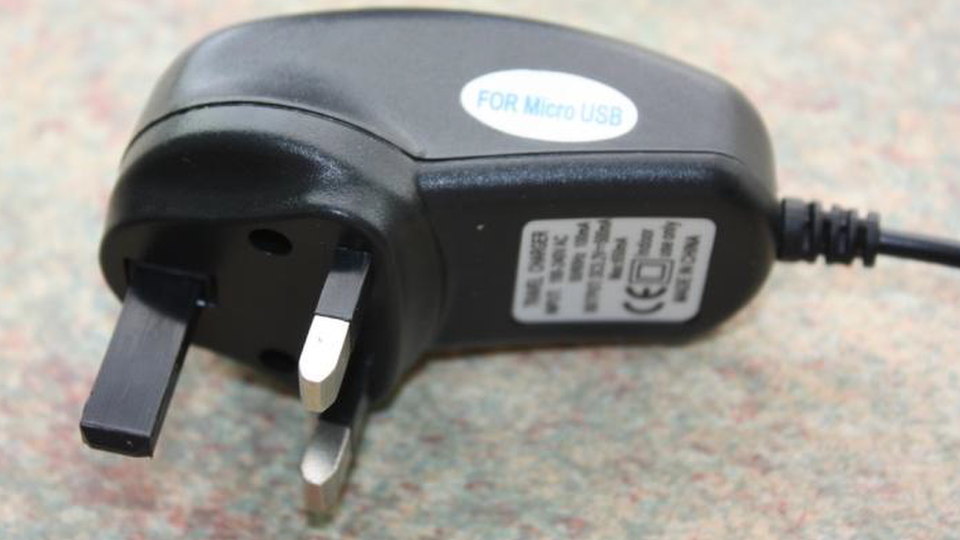How dangerous are phone chargers?
- Published

Generic phone chargers can be a problem, experts say
A fire which killed five people in a house in Sheffield was most likely caused by an "electrical fault involving a faulty charging device", investigators say. But what risks do chargers pose? And what can you do to minimise these?
Mobile phones, mp3 players, laptops, tablets, e-readers. The variety and number of mobile electronic devices that need charging is increasing all the time.
The biggest risk posed by chargers is the availability of cheap generic options online, according to fire and safety experts.
Chargers on auction sites are considerably cheaper than their branded counterparts but there is no guarantee they meet EU and UK safety standards.
Unofficial iPhone chargers are available on eBay for less than £1, whilst the total cost for a power adapter and USB from the online Apple store is £30.
Charity Electrical Safety First recently commissioned tests looking at the safety of chargers bought from online trading and auction sites.
It found that half had been wired using "sub-standard components" and none met with the safety requirements of the Electrical Equipment (Safety) Regulations Act 1994.
Some such chargers are bought online by individual customers. Others are bought en masse and end up being sold in markets and other small retail outlets, says Mark Gardiner, joint lead officer for product safety at the Trading Standards Institute (TSI).
Supermarkets and established retailers go through official channels, so do not face the same problems. They can trace their supply chain and cancel orders if there are faults.
Battery overheating
A central part of the safety concerns experts have with products bought online focuses on generic chargers - advertised as being compatible with a number of devices.
Mr Gardiner says that because different devices require different levels of charge, generic chargers run the risk of putting too much energy into a device, causing the battery to overheat.
Branded chargers are less likely to cause that problem because they are specifically designed for each particular device, Mr Gardiner said.
He adds that they are the most reliable in safety terms.
Philip Le Shirley, product safety adviser for the Royal Society for the Prevention of Accidents (RoSPA), says consumers should use the charger supplied with a product wherever possible.
If they cannot, they should only buy approved products.
He advises customers to:
Only buy approved chargers for products
Follow the manufacturer's instructions
Contact the manufacturer directly if in doubt.
Overnight charging
People should also avoid leaving devices to charge unattended, especially overnight, Mr Gardiner warned.
And it is important to think about where items are being left whilst they charge, South Yorkshire Fire and Rescue said.
For example, if a product is charged on a flammable surface, that increases the chance of a fire spreading.
They also warn against overloading sockets. Although strip adaptors are safe, they can only take a total of 13 amps.
All this comes as the European Commission backs plans to make mobile phone chargers to a common standard, external - a plan backed by manufacturers including Nokia, Apple, Samsung and Research In Motion.
It is likely that this would coincide with changes that would mean all chargers require the same input of power.
- Published12 May 2014

- Published9 June 2013

- Published30 December 2010